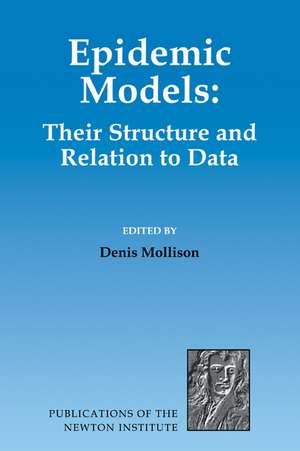Epidemic Models: Their Structure and Relation to Data: Publications of the Newton Institute, cartea 5
Editat de Denis Mollisonen Limba Engleză Paperback – 25 iun 2008
| Toate formatele și edițiile | Preț | Express |
|---|---|---|
| Paperback (1) | 486.85 lei 6-8 săpt. | |
| Cambridge University Press – 25 iun 2008 | 486.85 lei 6-8 săpt. | |
| Hardback (1) | 1008.11 lei 6-8 săpt. | |
| Cambridge University Press – 12 iul 1995 | 1008.11 lei 6-8 săpt. |
Din seria Publications of the Newton Institute
-
 Preț: 448.86 lei
Preț: 448.86 lei - 14%
 Preț: 1076.30 lei
Preț: 1076.30 lei - 11%
 Preț: 425.94 lei
Preț: 425.94 lei - 20%
 Preț: 644.44 lei
Preț: 644.44 lei - 11%
 Preț: 430.94 lei
Preț: 430.94 lei - 20%
 Preț: 303.67 lei
Preț: 303.67 lei - 14%
 Preț: 1488.13 lei
Preț: 1488.13 lei - 14%
 Preț: 789.17 lei
Preț: 789.17 lei - 20%
 Preț: 327.13 lei
Preț: 327.13 lei -
 Preț: 430.14 lei
Preț: 430.14 lei -
 Preț: 429.67 lei
Preț: 429.67 lei -
 Preț: 403.44 lei
Preț: 403.44 lei - 20%
 Preț: 773.34 lei
Preț: 773.34 lei - 11%
 Preț: 490.59 lei
Preț: 490.59 lei - 11%
 Preț: 491.66 lei
Preț: 491.66 lei - 14%
 Preț: 794.45 lei
Preț: 794.45 lei - 14%
 Preț: 1147.20 lei
Preț: 1147.20 lei
Preț: 486.85 lei
Preț vechi: 547.03 lei
-11% Nou
Puncte Express: 730
Preț estimativ în valută:
93.18€ • 96.91$ • 78.09£
93.18€ • 96.91$ • 78.09£
Carte tipărită la comandă
Livrare economică 14-28 martie
Preluare comenzi: 021 569.72.76
Specificații
ISBN-13: 9780521067287
ISBN-10: 0521067286
Pagini: 444
Ilustrații: 58 b/w illus.
Dimensiuni: 152 x 229 x 25 mm
Greutate: 0.65 kg
Editura: Cambridge University Press
Colecția Cambridge University Press
Seria Publications of the Newton Institute
Locul publicării:Cambridge, United Kingdom
ISBN-10: 0521067286
Pagini: 444
Ilustrații: 58 b/w illus.
Dimensiuni: 152 x 229 x 25 mm
Greutate: 0.65 kg
Editura: Cambridge University Press
Colecția Cambridge University Press
Seria Publications of the Newton Institute
Locul publicării:Cambridge, United Kingdom
Cuprins
Preface; Introduction; Part I. Conceptual Framework: 1. Some problems in the theory of infectious disease transmission and control Klaus Dietz; 2. The structure of epidemic models Denis Mollison; 3. Coupling methods in epidemic theory Frank Ball; 4. Collective epidemic processes: a general modelling approach to the final outcome of SIR epidemics Claude Lefévre and Philippe Picard; 5. The threshold concept in deterministic and stochastic models Ingemar Nasell; 6. How does transmission of infection depend on population size? Mart de Jong, Odo Diekmann and Hans Heesterbeek; 7. The legacy of Kermack and McKendrick Odo Diekmann, Hans Metz and Hans Heesterbeek; Part II. Spatial Models: 8. Incorporating spatial components into models of epidemic spread Andrew Cliff; 9. Velocities of epidemic spread Hans Metz and Frank van den Bosch; 10. Spatial epidemic models Richard Durrett; 11. A perturbation approach to nonlinear deterministic epidemic waves Henry Daniels; 12. Epidemic plant diseases: a stochastic model of leaf and stem lesion Lynne Billard, P. W. A. Dayananda and Zhen Zhao; Part III. Nonlinear Time and Space-Time Dynamics: 13. Detecting nonlinearity and chaos in epidemic data Stephen Ellner, Ronald Gallant and James Theiler; 14. Seasonality, demography and the dynamics of measles in developed countries Bryan Grenfell, Ben Bolker and Adam Kleczkowski; Part IV. Heterogeneity in Human Diseases: 15. Grouping in population models Simon Levin; 16. Core groups and R0s for subgroups in heterogeneous SIS and SI models John Jacquez, Carl Simon and James Koopman; 17. Data driven network models for the spread of disease Martina Morris; 18. The effect of antigenic diversity on endemic prevalence Sunetra Gupta, Katherine Trenholme, Martin Cox, Roy Anderson and Karen Day; Part V. Data Analysis: Estimation and Prediction: 19. Statistical challenges of epidemic data Niels Becker; 20. Primary components of epidemic models Andrew Cairns; 21. Estimation and prediction in tropical disease control: the example of onchocerciasis Hans Remme, Soumbey Alley and Anton Plaisier; 22. Some current trends in estimating vaccine efficacy Ira Longini, Elizabeth Halloran and Michael Haber; 23. Operational modelling of HIV/AIDS to assist public health control Norman Bailey; Appendix. Problem areas S. Ellner, O. Diekmann and N. Becker.
Recenzii
"The book is a nice reference work for students and researchers interested in epidemic models." JASA
Descriere
Surveys the state of epidemic modelling, resulting from the NATO Advanced Workshop at the Newton Institute in 1993.













